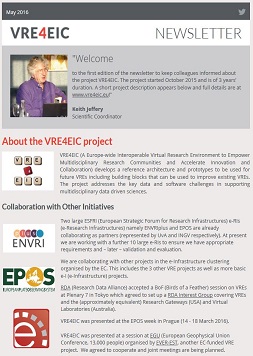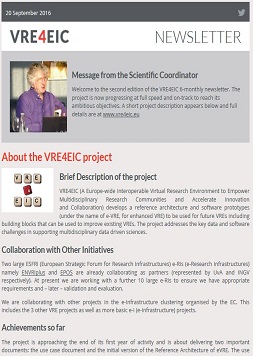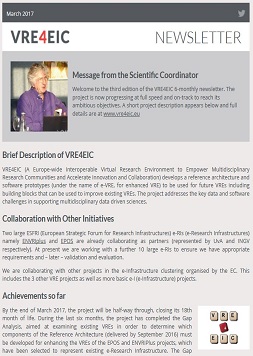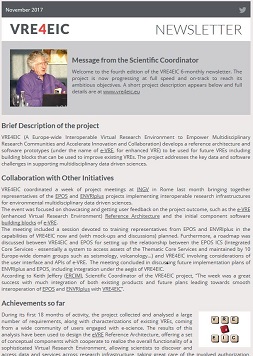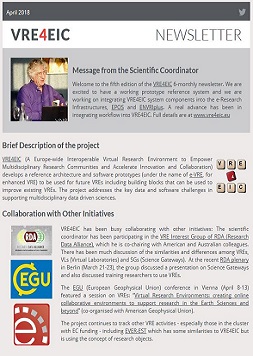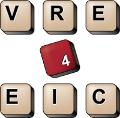
Sophia Antipolis, France – 25 June 2018
VRE4EIC releases video tutorials – VRE4EIC, an H2020 European research project, has released a series of video tutorials. Short online videos are explaining how to build a Virtual Research Environment (VRE) or to enhance an existing VRE.
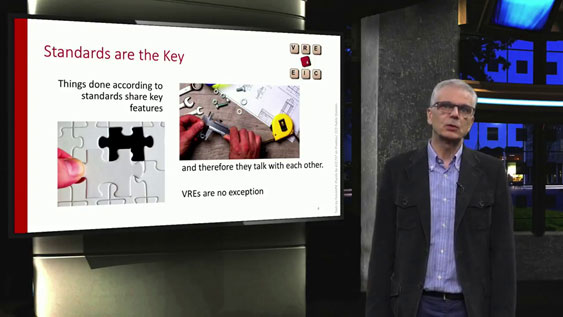
Researchers can access and use more and more research data in the digital age. They can use this data to obtain new insights, especially by combining datasets with other data. Various projects are already building e-Research Infrastructures to give researchers access to publicly funded research and open research data, and are developing towards Virtual Research Environments (VREs). VREs provide access to data, tools, and resources from different research infrastructures, facilitate co-operation or collaboration between researchers at the same or different institutions, at the intra- and inter-institutional levels, and preserve data and other outputs
VRE4EIC has developed a reference architecture and software components for building VREs. This software, called e-VRE, provides a comfortable, homogeneous interface for users by virtualising access to the heterogeneous datasets, software services and resources of the e-RIs, and provides collaboration/communication facilities for users to improve research communication. It also has the capability of bridging across existing e-RIs (e-Research Infrastructures).
With this series of tutorial videos, scientists and engineers can now learn how to build a VRE or enhance the functionalities of an existing VRE. Experts explain in a way easy to understand the different items and aspects of e-VRE: Keith Jeffery from ERCIM gives an introduction “What is a Virtual Research Environment”. Carlo Meghini from CNR gives insight in e-VRE architecture design & implementation”, explaining the architecture as well as set of software systems and tools of e-VRE. Laurent Remy from euroCRIS teaches how to manage metadata in Virtual Research Environments. Maria Theodoridou, FORTH, presents the VRE4EIC Metadata Portal. The first part of her tutorial introduces the core components and explains how to construct a basic query. The second part demonstrates advanced features of the portal: how to use the geographical map, how to expand basic into complex queries, and how to store and load queries.
Further videos explain how to use e-VRE to enhance an existing VRE. Daniele Bailo from the Italian National Institute for Geophysics and Volcanology (INGV) explains how building blocks (software tools) provided by VRE4EIC are enhancing an existing Research Infrastructure such as the European Plate Observation System (EPOS). Zhiming Zhao from University of Amsterdam (UvA) presents how the ENVRIPLUS community uses e-VRE architecture and building blocks for enhancing research infrastructures from different environmental and earth science domains (the video will be available in July).
“The videos are great means to demonstrate how easy it is to make use of e-VRE”, says Keith Jeffery (ERCIM), Scientific Coordinator of the VRE4EIC project. “The videos were produced by online e-learning experts of TU Delft, a partner of the VRE4EIC project, with the knowledge and experience to make engaging videos with an impact. The videos are highly interesting for both scientists who are in the need of a VRE, as well as for technicians who are building a VRE”.
The training videos are available online at /tutorials
e-VRE is the project software outcome, available under an open source software license for maximum uptake and community building. Preliminary versions are available on GitHub
About VRE4EIC
VRE4EIC is a 3-year Horizon 2020 research & innovation action (EINFRA-9-2015) coordinated by ERCIM and carried out with partners from The Netherlands (CWI, TU Delft, EuroCRIS and UvA), Italy (CNR and INGV) and Greece (FORTH). VRE4EIC stands for a Europe-wide interoperable Virtual Research Environment to Empower multidisciplinary research communities and accelerate Innovation and Collaboration. VRE4EIC is a 4,37m€ investment that has received funding from the European Union’s Horizon 2020 research and innovation programme under grant agreement No 676247.
VRE4EIC develops a reference architecture and software components for VREs (Virtual Research Environments). e-VRE bridges across existing e-RIs (e-Research Infrastructures) such as EPOS and ENVRIplus, both represented in the project, themselves supported by e-Is (e-Infrastructures) such as GEANT, EUDAT, PRACE, EGI, OpenAIRE. The e-VRE provides a comfortable homogeneous interface for users by virtualising access to the heterogeneous datasets, software services, and resources of the e-RIs and provides collaboration/communication facilities for users to improve research communication. Finally, it provides access to research management /administrative facilities so that the end-user has a complete research environment.
More information: www.vre4eic.eu
About ERCIM GEIE
ERCIM - the European Research Consortium for Informatics and Mathematics - aims to foster collaborative initiatives within the European research community and to increase co-operation with European industry. Leading European research institutes are members of ERCIM. ERCIM is based in Sophia Antipolis, France.
More information: www.ercim.eu
Contacts:
ERCIM
Keith Jeffery, +44 7768 446088, This email address is being protected from spambots. You need JavaScript enabled to view it.
Peter Kunz, +33 7 68165047, This email address is being protected from spambots. You need JavaScript enabled to view it.
